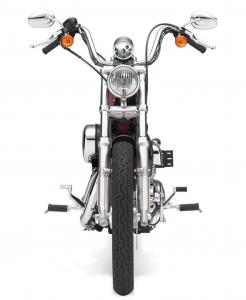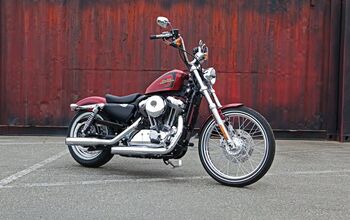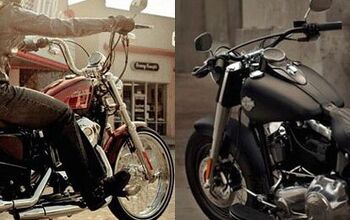2012 Harley-Davidson Seventy-Two Review - Motorcycle.com
Afros were worn loud and proud, as were polyester bellbottom pants and wide-collar shirts; America’s Team, the Dallas Cowboys, was a force to fear, ABC had itself a genuine hit with The Love Boat, and President Carter signed airline deregulation into law. Music from the likes of Led Zeppelin and Black Sabbath provided a hard-edged option to disco, while Star Wars, Jaws, Close Encounters of The Third Kind and The Godfather were packin’ ‘em in at the theater.
Hello? It’s the ‘70s calling.
The cultural hallmarks (some of them more forgettable than others) above paint a broad picture of the post-Vietnam social era in America. Part of that era was an expanding sense of individualism, perhaps no better realized and materialized than in the chopper motorcycle. A counterculture of fully customized rides with crazy-long raked front-ends, sissy bars, no front brakes and thundering exhausts burgeoned in California, from the Bay Area to SoCal, during the ‘70s.
And so this is partially where, or rather when, Harley-Davidson reached for inspiration and styling direction for its recently unveiled Sportster 1200-based Seventy-Two.
Along with its styling, the Harley-Davidson Seventy-Two pays tribute to the cruising and customizing scene in Southern California by taking its namesake from California State Route 72, aka Whittier Boulevard, a street long known as a cruising hangout in Greater Los Angeles.
As a modern representative of the early chopper scene, the Seventy-Two bears some signature chopper cues, like its 2.1-gallon peanut tank (on loan from another retro ride, the Forty-Eight), solo saddle, side-mounted license plate, mini-ape hanger handlebar, staggered dual exhaust, wire wheels rolling on white-wall tires, chopped rear fender and of course, metal-flake paint. Bow-chicka-wow-wow bow-chicka-wow-wow…
If you’re into the minimalist thing, and admire a bike with only the basics in view, then the Seventy-Two is a looker. Harley has done well in keeping this retro-fied ride looking classy and classic. Numerous components wear liquid-like chrome with a high-luster, quality finish, and are nicely balanced by the muted tones of the tank, fender and oil bag paint.
Your gaze is drawn to the gleaming engine and exhaust, yet the Seventy-Two avoids looking gaudy, like H-D went over-the-top with the shiny stuff. The skinny spoke front wheel and tiny tank create an airy, unencumbered presence. About the only item I’d ditch ASAP is the bulky, industrial-looking horn mount that’s bolted to the upper left-hand side of each cylinder. I realize the horn is a necessity; its chrome cover looks good on its own, and H-D blacked out the bracket as best as possible. However, visualizing the horn’s absence from that spot I could see how much cleaner and better highlighted the Harley Twin would look.
Pleased with the Seventy-Two’s appearance, I feared the Spartan rider accommodations dictated by the bike’s stripped-down ethos would offset my good first impression of this latest Sportster. Caught off guard is how I’d describe my reaction after slinging a leg over the first time.
Although the dual coil-over-spring shocks only provide 2.1 inches of travel (pretty typical of many late-model Harleys), a seat height of 28.0 inches towers over most other Harley cruisers and is a stark contrast to the way-low seat height theme of many other steeds in the H-D stable. Continuing the shock and awe, the forward controls (footpegs) felt unusually high. With right and left lean angle clearance at 28.6 and 29.8 degrees respectively, the Seventy-Two provides, at a minimum, 1 to 2 degrees more clearance than the Forty-Eight, Custom 1200 and SuperLow Sportster models (the sportbike-like XR1200X of course has lots more room to lean, and the Nightster and Iron 883 have a little more than 1.0 degree than the Seventy-Two).
Riding high, the 10-inch tall mini-apes on 2.0-inch risers round out the rest of the rider triangle and complement the high seat and pegs. Overall, the ergo layout felt well proportioned and natural to my 5-foot 8-inch and 30-inch inseam build. However, with 60-plus miles of freeway at the head of my initial ride it wasn’t long before I discovered that riding the Harley-Davidson Seventy-Two is ultimately always fun, but it’s less pleasurable to ride in certain settings than in others.
The Seventy-Two’s mechanicals (engine, brakes, etc.) are standard-issue Sportster stuff, and by that I mean familiar, like an ol’ buddy. But do heed the caveat that the peanutty 2.1-gallon tank empties quickly – you’ll get roughly 100 miles from full up if you’re judicious with throttle application, but expect the low fuel warning to illuminate as early as 60 miles in.
Trying to keep pace with L.A. traffic running upwards of 80 mph on the freeway proved too much of a chore as the fists-high-in-the-wind riding position means plenty of Popeye forearm strength is necessary to combat the windblast. Although 5.7 inches of front suspension travel from the spindly 39mm fork seems sufficient for most bumps, the stingy meat on the narrow 21-inch front wheel doesn’t provide much bump absorption, so expansion joints and cracks transmit quickly to the rider. After 50-ish freeway miles I bailed out for the relative comfort of surface street riding.
The Seventy-Two is much more at home profiling down the boulevard, or even on curvy roads, than long stints on the highway. With a comparatively modest 555-pound running order weight, the Seventy-Two changes direction without much effort; the single dual-piston front brake caliper isn’t overwhelmed, and the 1200cc (73.3 c.i.) 5-speed Sportster V-Twin feels especially spirited – I could even squeeze out a tiny wheelie at times when pulling away from stop.
Ready for your personal touch, man
If I owned a Seventy-Two I wouldn’t do a lot of customization to this Harley, especially to the beautifully painted Hard Candy Big Red Flake scheme – at risk of chafing some, I think the bike’s aura begs for a set of naughty exhaust pipes.
But since Harley’s done a lot of the heavy lifting by keeping styling tight and simple, the Seventy-Two also strikes me as a blank sheet waiting for a rider to personalize it into a one-off modern-day chopper. And a base price of just $10,499 leaves lots of room to get yo’ groove on. But even if you didn’t so much as change a screw to alter the Harley-Davidson Seventy-Two you’d have yourself a special ride. No other major OEM has anything quite like it.
Related Reading
2012 Harley-Davidson Seventy-Two and Softail Slim Preview
2012 Harley-Davidson Dyna Street Bob Review
2012 Harley-Davidson Sportster SuperLow Review
2010 Harley-Davidson Forty-Eight Review
All Things Harley-Davidson on Motorcycle.com
More by Pete Brissette


































Comments
Join the conversation